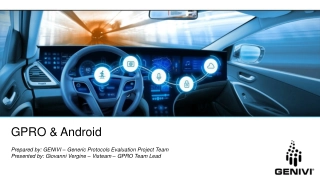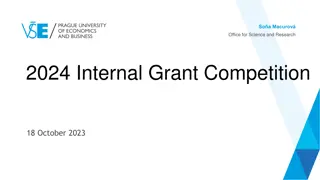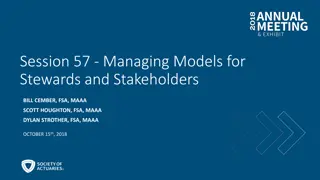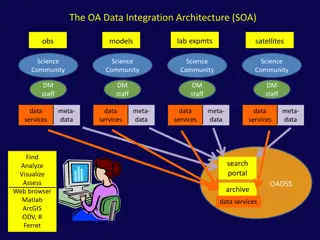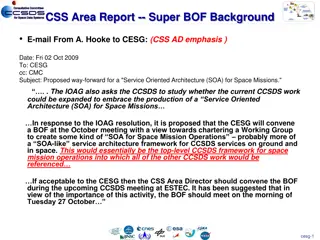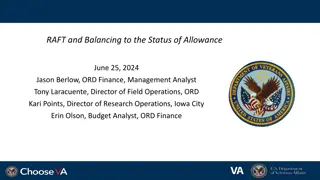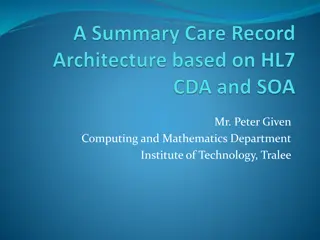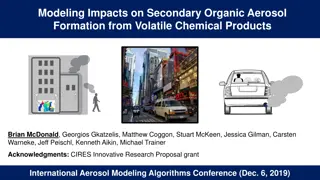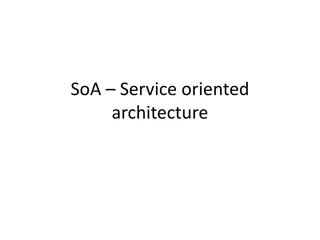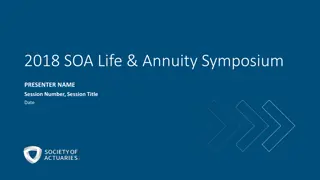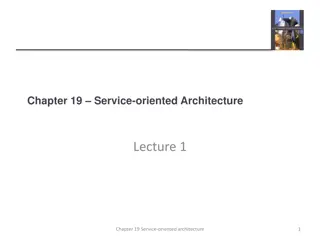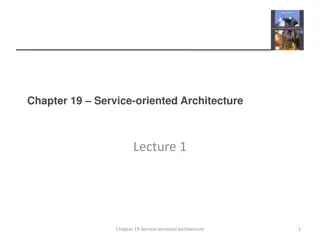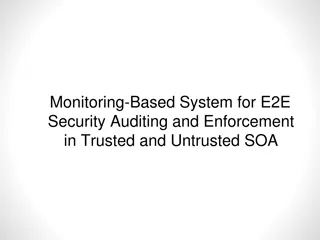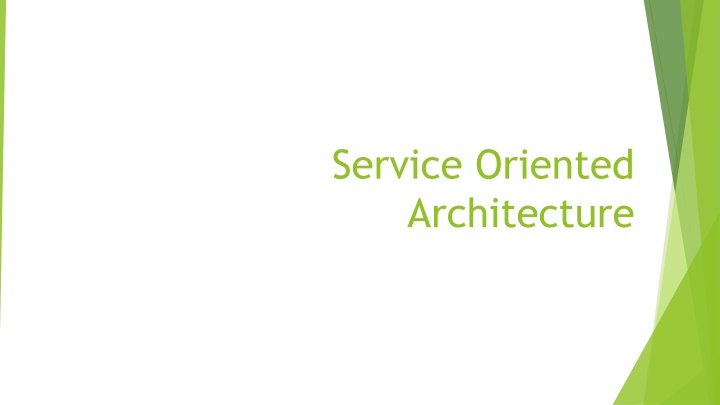
Service-Oriented Architecture (SOA) and XML
Delve into the world of Service-Oriented Architecture, a powerful software design pattern where application components provide services over a network, independent of vendors or technologies. Explore the concepts, principles, types of services, benefits, and the role of XML in defining new document formats for the World Wide Web.
Download Presentation

Please find below an Image/Link to download the presentation.
The content on the website is provided AS IS for your information and personal use only. It may not be sold, licensed, or shared on other websites without obtaining consent from the author. If you encounter any issues during the download, it is possible that the publisher has removed the file from their server.
You are allowed to download the files provided on this website for personal or commercial use, subject to the condition that they are used lawfully. All files are the property of their respective owners.
The content on the website is provided AS IS for your information and personal use only. It may not be sold, licensed, or shared on other websites without obtaining consent from the author.
E N D
Presentation Transcript
Service Oriented Architecture
Service Oriented Architecture SOA is an architectural pattern in software design. SOA application components provide services to other components via a communications protocol, typically over a network. The principles of service-orientation are independent of any vendor, product or technology.
SOA Concepts and Principles Design Concept SOA is based on the concept of a service. Depending on the service design approach taken, Each SOA service is designed to perform one or more activities by implementing one or more service operations. SOA defines how to integrate widely disparate applications for a Web-based environment and uses multiple implementation platforms. Rather than defining an API, SOA defines the interface in terms of protocols and functionality. An endpoint is the entry point for such a SOA implementation.
Types of SOA services There are several types of services used in SOA systems. Business services Entity services Functional services Utility services
SOA benefits Ability to build business applications faster and more easily Easier maintenance / update Business agility and extensibility Lower total cost of ownership
XML The eXtensible Markup Language (XML), Derived from the Standard Generalized Markup Language (SGML), Was originally envisioned as a language for defining new document formats for the World Wide Web
XML Document <?xml version="1.0" encoding="UTF-8" ?> <order id="1234" date="05/06/2013"> <customer first_name="James" last_name="Rorrison"> <email>j.rorri@me.com</email> <phoneNumber>+44 1234 1234</phoneNumber> </customer> <content> <order_line item="H2G2" quantity="1"> <unit_price>23.5</unit_price> </order_line> <order_line item="Harry Potter" quantity="2"> <unit_price>34.99</unit_price> </order_line> </content> <credit_card number="1357" expiry_date="10/13" control_number="234" type="Visa"/> </order>
XML Terminology Terminology Unicode character Definition An XML document is a string of characters represented by almost every legal Unicode character The Unicode characters are divided into markup and content. Markups begin with the character < and end with a > (<email>) and what is not markup is considered to be content (such as j.rorri@me.com) Tags come in three flavors of markups: start-tags (<email>), end-tags (</email>) and empty-element tags (<email/>) An element begins with a start-tag and ends with a matching end-tag (or consists only of an empty-element tag). It can also include other elements, which are called child elements. An example of an element is <email>j.rorri@me.com</email> An attribute consists of a name/value pair that exists within a start-tag or empty-element tag. In the following example item is the attribute of the order_line tag: <order_line item="H2G2"> XML documents may begin by declaring some information about themselves, as in the following example: <?xml version="1.0" encoding="UTF-8" ?> Markup and content Tag Element Attribute XML Declaration
XML Binding in Java JAXB: Java Architecture for XML Binding
SOAP (Simple Object Access protocol) It is a protocol specification for exchanging structured information in the implementation of web services in computer networks. It uses XML Information Set for its message format, and relies on other application layer protocols, most notably Hypertext Transfer Protocol (HTTP), or Simple Mail Transfer Protocol (SMTP), for message negotiation and transmission.
SOAP Elements and Attributes Element Envelope Defines the message and the namespace used in the document. This is a required root element Header Contains any optional attributes of the message or application-specific infrastructure such as security information or network routing Body Contains the message being exchanged between applications Fault Provides information about errors that occur while the message is processed. This element is optional Description
SOAP Request POST /InStock HTTP/1.1 Host: www.bookshop.org Content-Type: application/soap+xml; charset=utf-8 Content-Length: nnn <?xml version="1.0"?> <soap:Envelope xmlns:soap="http://www.w3.org/2001/12/soap-envelope" soap:encodingStyle="http://www.w3.org/2001/12/soap-encoding"> <soap:Body xmlns:m="http://www.bookshop.org/prices"> <m:GetBookPrice> <m:BookName>The Fleamarket</m:BookName> </m:GetBookPrice> </soap:Body> </soap:Envelope>
SOAP Response POST /InStock HTTP/1.1 Host: www.bookshop.org Content-Type: application/soap+xml; charset=utf-8 Content-Length: nnn <?xml version="1.0"?> <soap:Envelope xmlns:soap="http://www.w3.org/2001/12/soap-envelope" soap:encodingStyle="http://www.w3.org/2001/12/soap-encoding"> <soap:Body xmlns:m="http://www.bookshop.org/prices"> <m:GetBookPriceResponse> <m: Price>10.95</m: Price> </m:GetBookPriceResponse> </soap:Body> </soap:Envelope>
Web Services Web service is a realization of SOA. It is important to note that the SOA is an architectural model that is independent of any technology platform and Web Services the most popular SOA implementation. As the name implies, web services offers services over the web. This is not surprising as the choice of the Internet it already connects many different systems from all over the world.
Web Services Terminologies Hypertext transfer protocol [HTTP] Extensible Markup Language [XML] Web Services Description Language [WSDL] SOAP
How Do Web Services Work? A Web service enables this communication by using a combination of open protocols and standards, chiefly XML, SOAP and WSDL. A Web service uses XML to tag data, SOAP to transfer a message and finally WSDL to describe the availability of services.

